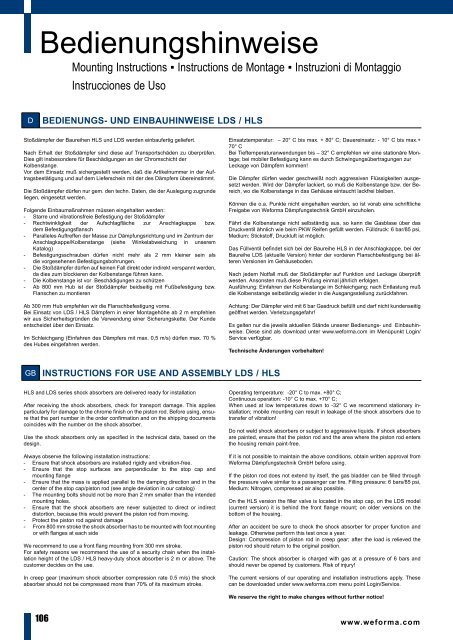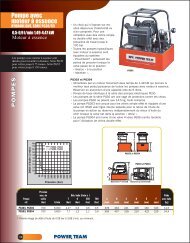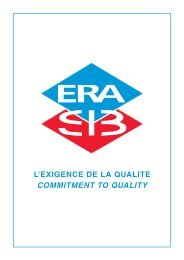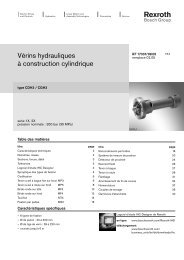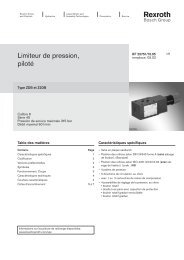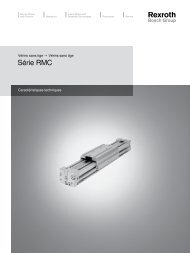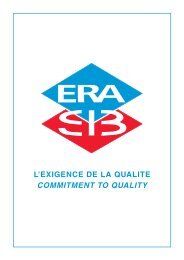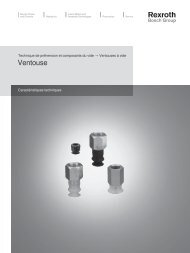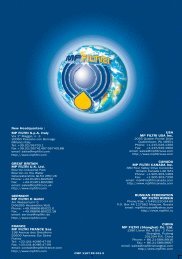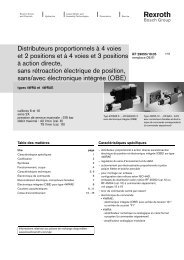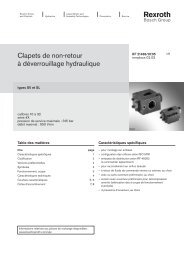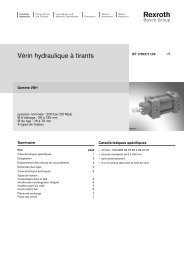ProSurf
ProSurf
ProSurf
You also want an ePaper? Increase the reach of your titles
YUMPU automatically turns print PDFs into web optimized ePapers that Google loves.
Bedienungshinweise<br />
Mounting Instructions ▪ Instructions de Montage ▪ Instruzioni di Montaggio<br />
Instrucciones de Uso<br />
D<br />
Bedienungs- und Einbauhinweise LDS / HLS<br />
Stoßdämpfer der Baureihen HLS und LDS werden einbaufertig geliefert.<br />
Nach Erhalt der Stoßdämpfer sind diese auf Transportschäden zu überprüfen.<br />
Dies gilt insbesondere für Beschädigungen an der Chromschicht der<br />
Kolbenstange.<br />
Vor dem Einsatz muß sichergestellt werden, daß die Artikelnummer in der Auftragsbestätigung<br />
und auf dem Lieferschein mit der des Dämpfers übereinstimmt.<br />
Die Stoßdämpfer dürfen nur gem. den techn. Daten, die der Auslegung zugrunde<br />
liegen, eingesetzt werden.<br />
Folgende Einbaumaßnahmen müssen eingehalten werden:<br />
- Starre und vibrationsfreie Befestigung der Stoßdämpfer<br />
- Rechtwinkligkeit der Aufschlagfläche zur Anschlagkappe bzw.<br />
dem Befestigungsflansch<br />
- Paralleles Auftreffen der Masse zur Dämpfungsrichtung und im Zentrum der<br />
Anschlagkappe/Kolbenstange (siehe Winkelabweichung in unserem<br />
Katalog)<br />
- Befestigungsschrauben dürfen nicht mehr als 2 mm kleiner sein als<br />
die vorgesehenen Befestigungsbohrungen.<br />
- Die Stoßdämpfer dürfen auf keinen Fall direkt oder indirekt verspannt werden,<br />
da dies zum blockieren der Kolbenstange führen kann.<br />
- Die Kolbenstange ist vor Beschädigungen zu schützen<br />
- Ab 800 mm Hub ist der Stoßdämpfer beidseitig mit Fußbefestigung bzw.<br />
Flanschen zu montieren<br />
Ab 300 mm Hub empfehlen wir die Flanschbefestigung vorne.<br />
Bei Einsatz von LDS / HLS Dämpfern in einer Montagehöhe ab 2 m empfehlen<br />
wir aus Sicherheitsgründen die Verwendung einer Sicherungskette. Der Kunde<br />
entscheidet über den Einsatz.<br />
Im Schleichgang (Einfahren des Dämpfers mit max. 0,5 m/s) dürfen max. 70 %<br />
des Hubes eingefahren werden.<br />
Einsatztemperatur: – 20° C bis max. + 80° C; Dauereinsatz: - 10° C bis max.+<br />
70° C<br />
Bei Tieftemperaturanwendungen bis – 32° C empfehlen wir eine stationäre Montage;<br />
bei mobiler Befestigung kann es durch Schwingungsübertragungen zur<br />
Leckage von Dämpfern kommen!<br />
Die Dämpfer dürfen weder geschweißt noch aggressiven Flüssigkeiten ausgesetzt<br />
werden. Wird der Dämpfer lackiert, so muß die Kolbenstange bzw. der Bereich,<br />
wo die Kolbenstange in das Gehäuse eintaucht lackfrei bleiben.<br />
Können die o.a. Punkte nicht eingehalten werden, so ist vorab eine schriftliche<br />
Freigabe von Weforma Dämpfungstechnik GmbH einzuholen.<br />
Fährt die Kolbenstange nicht selbständig aus, so kann die Gasblase über das<br />
Druckventil ähnlich wie beim PKW Reifen gefüllt werden. Fülldruck: 6 bar/85 psi,<br />
Medium: Stickstoff, Druckluft ist möglich.<br />
Das Füllventil befindet sich bei der Baureihe HLS in der Anschlagkappe, bei der<br />
Baureihe LDS (aktuelle Version) hinter der vorderen Flanschbefestigung bei älteren<br />
Versionen im Gehäuseboden.<br />
Nach jedem Notfall muß der Stoßdämpfer auf Funktion und Leckage überprüft<br />
werden. Ansonsten muß diese Prüfung einmal jährlich erfolgen.<br />
Ausführung: Einfahren der Kolbenstange im Schleichgang; nach Entlastung muß<br />
die Kolbenstange selbständig wieder in die Ausgangsstellung zurückfahren.<br />
Achtung: Der Dämpfer wird mit 6 bar Gasdruck befüllt und darf nicht kundenseitig<br />
geöffnet werden. Verletzungsgefahr!<br />
Es gelten nur die jeweils aktuellen Stände unserer Bedienungs- und Einbauhinweise.<br />
Diese sind als download unter www.weforma.com im Menüpunkt Login/<br />
Service verfügbar.<br />
Technische Änderungen vorbehalten!<br />
GB<br />
Instructions for use and assembly LDS / HLS<br />
HLS and LDS series shock absorbers are delivered ready for installation<br />
After receiving the shock absorbers, check for transport damage. This applies<br />
particularly for damage to the chrome finish on the piston rod. Before using, ensure<br />
that the part number in the order confirmation and on the shipping documents<br />
coincides with the number on the shock absorber.<br />
Use the shock absorbers only as specified in the technical data, based on the<br />
design.<br />
Always observe the following installation instructions:<br />
- Ensure that shock absorbers are installed rigidly and vibration-free.<br />
- Ensure that the stop surfaces are perpendicular to the stop cap and<br />
mounting flange<br />
- Ensure that the mass is applied parallel to the damping direction and in the<br />
center of the stop cap/piston rod (see angle deviation in our catalog)<br />
- The mounting bolts should not be more than 2 mm smaller than the intended<br />
mounting holes.<br />
- Ensure that the shock absorbers are never subjected to direct or indirect<br />
distortion, because this would prevent the piston rod from moving.<br />
- Protect the piston rod against damage<br />
- From 800 mm stroke the shock absorber has to be mounted with foot mounting<br />
or with flanges at each side<br />
We recommend to use a front flang mounting from 300 mm stroke.<br />
For safety reasons we recommend the use of a security chain when the installation<br />
height of the LDS / HLS heavy-duty shock absorber is 2 m or above. The<br />
customer decides on the use.<br />
In creep gear (maximum shock absorber compression rate 0.5 m/s) the shock<br />
absorber should not be compressed more than 70% of its maximum stroke.<br />
Operating temperature: -20° C to max. +80° C;<br />
Continuous operation: -10° C to max. +70° C;<br />
When used at low temperatures down to -32° C we recommend stationary installation;<br />
mobile mounting can result in leakage of the shock absorbers due to<br />
transfer of vibration!<br />
Do not weld shock absorbers or subject to aggressive liquids. If shock absorbers<br />
are painted, ensure that the piston rod and the area where the piston rod enters<br />
the housing remain paint-free.<br />
If it is not possible to maintain the above conditions, obtain written approval from<br />
Weforma Dämpfungstechnik GmbH before using.<br />
If the piston rod does not extend by itself, the gas bladder can be filled through<br />
the pressure valve similar to a passenger car tire. Filling pressure: 6 bars/85 psi,<br />
Medium: Nitrogen, compressed air also possible.<br />
On the HLS version the filler valve is located in the stop cap, on the LDS model<br />
(current version) it is behind the front flange mount; on older versions on the<br />
bottom of the housing.<br />
After an accident be sure to check the shock absorber for proper function and<br />
leakage. Otherwise perform this test once a year.<br />
Design: Compression of piston rod in creep gear; after the load is relieved the<br />
piston rod should return to the original position.<br />
Caution: The shock absorber is charged with gas at a pressure of 6 bars and<br />
should never be opened by customers. Risk of injury!<br />
The current versions of our operating and installation instructions apply. These<br />
can be downloaded under www.weforma.com menu point Login/Service.<br />
We reserve the right to make changes without further notice!<br />
106<br />
www.weforma.com


